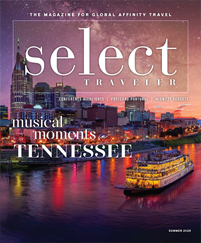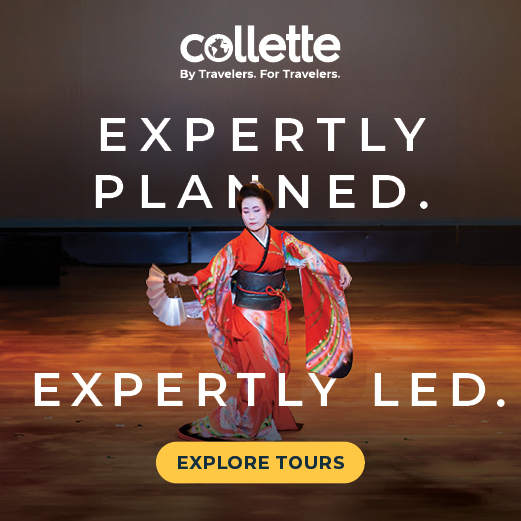Authenticity makes for great travel. By that measure, my trip to the French Riviera could not have gotten off to a better start.
On the night of our arrival for a Collette Spotlight tour in Nice, several of us had drinks in the Hotel Ellington after our dinner at Restaurant Barracuda. A young Frenchman came over and invited us to join his group. They were outside in the hotel courtyard, so we cleared our tab and joined them.
Becky Regan, our tour director; Yumi Kim, a traveler from New Jersey; and I sat with them and had lengthy conversations about France and America. Two of our French companions, both young professionals, had been to the United States and loved it. They said America represents freedom to them. They associate our country with the open road and independence.
One was concerned about the recent incidents in Paris and the resulting need for visible security in the form of strolling soldiers or police. He felt the country’s “joie de vivre” had taken a hit.
The three of us assured him that the bohemian beauty and laissez-faire charm of his country was still apparent to us. Truthfully, the occasional appearance of uniformed security at the airport or in a busy square was reassuring to me.
Nice Up Close
I was thrilled to be doing this Spotlight tour because I had been wanting to try an immersion trip that offered lots of free time and focused on a single city. The leisurely pace meant we had breakfast on our own in the hotel each morning and didn’t depart as a group until 9:30 or so. Anyone who wanted to go for a run or workout had plenty of time to do so.
Our first full day, Becky walked us through the heart of this seaside city, the fourth largest in France. The Cote d’Azur (Blue Coast) stretches along the southeastern coast of France and includes other resort destinations like St. Tropez, Cannes and Monaco. The Mediterranean’s sparkling blue waters illuminate every aspect of life here.
Our point of reference for navigating Nice was Avenue Jean Medicin, the retail artery that leads through town to the Promenade des Anglais, a bustling beachfront thoroughfare that follows the Mediterranean coast. Along the Promenade, sunbathers gather on the rocky beach and enjoy drinks in open-air bars.
We strolled through Old Town Nice, where shops and cafes crowd narrow streets. We visited its heralded flower market and finished up on the Promenade, where Becky turned us loose for the afternoon.
“Remember,” she said. “Sometimes in Old Town the shops close between noon and 2 so the owners can have a nice lunch.” Just then, a cannon went off from high above us on Castle Hill, the city’s fortification landmark that dates to the third century. “That’s the midday cannon shot,” said Becky. “That’s been a daily tradition since 1861 — ever since a Scottish lord fired a cannon at noon to remind his wife he wanted his lunch.”
Yumi wanted oysters for lunch and one of the Frenchmen the night before had recommended Café de Turin near Garibaldi Square. We made our way back through Old Town and over to that century-old streetside eatery. The oysters were superb. They originated from Brittany on the northwest coast of France and were meaty and delicious.
Afterward, I found a city bus and spent the rest of the day around the Matisse Museum. Henri Matisse lived and worked in Nice from 1817 until 1854 and personally donated many of the museum’s pieces, which include paintings, drawings, tapestries and sculptures. It rests high atop a hill in the neighborhood of Cimiez, where a large public park draws picnickers and old men play bocce. Matisse is buried nearby at the Cimiez Monastery.
That evening, I found a busy outdoor café on Rue Massena, a dining nexus off Avenue Jean Medicin, and ordered an ink squid risotto with scallops. I’d never had an ink squid dish, and when it arrived, it was the blackest plate of food I’ve ever seen. It was so black I wondered if the table next to me was discussing it. I devoured the scallops and did what I could with the black risotto.
The Rich and Famous
“The Grimaldis have ruled Monaco for 700 years — ever since a lord declared himself a prince,” said Becky, as we arrived in Monaco Ville, Monaco. “Some of you may want to stroll through town and do a little window licking. That’s French for window shopping.”
I’m not much for window licking, so I headed over to the Oceanographic Museum, which has lifelong ties to French oceanographer Jacques Cousteau, and spent an hour or so.
Upon arrival in Monte Carlo, Monaco, several in our group went to the Monte Carlo Casino, but a few of us stayed outside to watch Sunday drivers in sports cars rumble through the park. A huge terrace bar sits opposite the casino and the nearby Hotel de Paris. Like hundreds of others on this gorgeous afternoon, we had a beer and watched the constant parade of Porsches, Lamborghinis, Ferraris and misguided Hondas.
We arrived for dinner that evening in Eze, but a mist rolled in before we could get clear views of the vistas from this penultimate perch on the sea. This tiny medieval enclave corkscrews up a steep mountainside some 1,400 feet above the Mediterranean. Its galleries ooze original art and I’d love to go back. We had a boisterous dinner there at Le Pinocchio, triggered by liberal servings of French wine.









